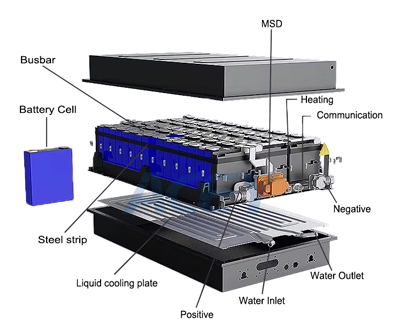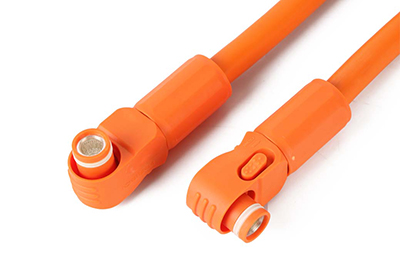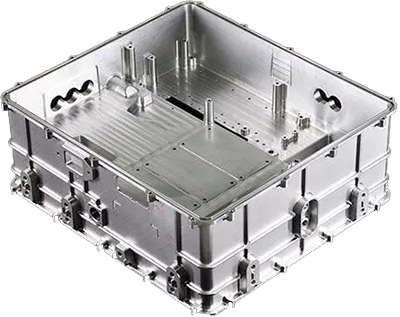Ńé½ŃāåŃé┤Ńā¬
µ¢░ŃüŚŃüäŃā¢ŃāŁŃé░
Ńā¬ŃāüŃé”ŃāĀŃéżŃé¬Ńā│ķø╗µ▒ĀŃé©ŃāŹŃā½Ńé«Ńā╝Ķ▓»ĶöĄŃéĘŃé╣ŃāåŃāĀŃü©Ńü»õĮĢŃü¦ŃüÖŃüŗ?
August 16 , 20241. Õ«ÜńŠ®
Ńā¬ŃāüŃé”ŃāĀŃéżŃé¬Ńā│ķø╗µ▒ĀŃāæŃāāŃé»Ńü»ķø╗µ▒ĀŃāóŃéĖŃāźŃā╝Ńā½Ńü©ŃééÕæ╝Ńü░ŃéīŃĆüŃā¬ŃāüŃé”ŃāĀŃéżŃé¬Ńā│ķø╗µ▒ĀŃü«ĶŻĮķĆĀÕĘźń©ŗŃü¦ŃüÖŃĆéĶżćµĢ░Ńü«Ńā¬ŃāüŃé”ŃāĀŃéżŃé¬Ńā│Ńé╗Ńā½ŃéÆńø┤ÕłŚŃüŖŃéłŃü│õĖ”ÕłŚŃü½µÄźńČÜŃüŚŃü”ŃāæŃāāŃé▒Ńā╝ŃéĖŃā│Ńé░ŃĆüŃé½ŃāŚŃé╗Ńā½Õī¢ŃĆüńĄäŃü┐ń½ŗŃü”ŃéÆĶĪīŃüäŃüŠŃüÖŃĆéŃüōŃü«ÕĘźń©ŗŃü¦Ńü»ŃĆüµ®¤µó░ńÜäÕ╝ĘÕ║”ŃĆüńå▒ń«ĪńÉåŃĆüķø╗µ▒Āń«ĪńÉåŃéĘŃé╣ŃāåŃāĀ (BMS) Ńü«õ║ƵÅøµĆ¦Ńü¬Ńü®Ńü«Ķ”üń┤ĀŃééĶĆāµģ«ŃüĢŃéīŃüŠŃüÖŃĆé
ŃāæŃāāŃé»ÕĘźń©ŗŃü«õĖ╗Ķ”üµŖĆĶĪōŃü½Ńü»ŃĆüÕģ©õĮōńÜäŃü¬µ¦ŗķĆĀĶ©ŁĶ©łŃĆüµ║ȵğŃüŖŃéłŃü│Õć”ńÉåÕłČÕŠĪŃĆüõ┐ØĶŁĘŃā¼ŃāÖŃā½ŃĆüŃéóŃé»ŃāåŃéŻŃā¢ńå▒ń«ĪńÉåŃéĘŃé╣ŃāåŃāĀŃü¬Ńü®ŃüīŃüéŃéŖŃüŠŃüÖŃĆéķĪ¦Õ«óŃü«Ķ”üõ╗ČŃü½Õ┐£ŃüśŃü” 2 Ńüżõ╗źõĖŖŃü«Ńé╗Ńā½ŃéÆńø┤ÕłŚŃüŠŃü¤Ńü»õĖ”ÕłŚŃü½µÄźńČÜŃüŚŃü”ńē╣Õ«ÜŃü«ÕĮóńŖČŃéÆÕĮóµłÉŃüÖŃéŗÕĀ┤ÕÉłŃĆüŃüØŃéīŃü»ŃāæŃāāŃé»Ńü©Õæ╝Ńü░ŃéīŃüŠŃüÖŃĆé
2. ķø╗µ▒ĀŃāæŃāāŃé»Ńü«Ńé│Ńā│ŃāØŃā╝ŃāŹŃā│Ńāł
ķø╗µ▒ĀŃāæŃāāŃé»Ńü»ŃĆüõĖ╗Ńü½ÕŹśõĖĆŃü«ķø╗µ▒ĀŃāóŃéĖŃāźŃā╝Ńā½ŃĆüķø╗µ░ŚŃéĘŃé╣ŃāåŃāĀŃĆüńå▒ń«ĪńÉåŃéĘŃé╣ŃāåŃāĀŃĆüŃā£ŃāāŃé»Ńé╣ŃĆüBMS Ńü¬Ńü®Ńü¦µ¦ŗµłÉŃüĢŃéīŃü”ŃüäŃüŠŃüÖŃĆé

Ķ¦ÆÕ×ŗŃāÉŃāāŃāåŃā¬Ńā╝ŃāæŃāāŃ黵¦ŗķĆĀÕø│

Ńé©ŃāŹŃā½Ńé«Ńā╝Ķ▓»ĶöĄķ½śķø╗Õ£¦ķģŹńĘÜŃāÅŃā╝ŃāŹŃé╣

ŃāÉŃāāŃāåŃā¬Ńā╝ŃāæŃāāŃé»Ńé▒Ńā╝Ńé╣µ£¼õĮō
3. ŃāÉŃāāŃāåŃā¬Ńā╝ŃāæŃāāŃé»Ńü«ńē╣µĆ¦
How to ensure that the battery has a high degree of consistency?
This requires the use of specialized battery charge discharge test equipment to sort the battery capacity and screen its performance. By performing charge and discharge tests on each lithium battery, the computer records the data of each test point, and thus obtains the capacity and internal resistance of each battery, and determines the quality grade of the lithium battery. The battery can quickly and accurately evaluate the capacity and performance of the battery through efficient cycle charge and discharge tests.
4. Methods of Pack Formation
Ō¢ČSeries and Parallel Configuration:
The battery module is formed by connecting individual cells in series and parallel. Parallel connections increase capacity while keeping the voltage constant, while series connections increase voltage while keeping the capacity constant.
Ō¢ČCell Requirements:
Based on design requirements, select the corresponding cells. The batteries used in parallel or series must be of the same type, model, and have similar capacities, internal resistance, and voltage, with differences not exceeding 2%. Regardless of whether soft-pack batteries or cylindrical batteries are used, multiple cells need to be combined in series.
Ō¢ČPack Process:
The pack process can be achieved through two main methods:
Handheld/Automatic Fiber Laser Welding Machine
Considering production yield, efficiency, and the internal resistance of connection points, laser welding has become the preferred choice for many battery manufacturers.
Acey New Energy Ńü»ŃĆü Ńā¬ŃāüŃé”ŃāĀŃéżŃé¬Ńā│ķø╗µ▒ĀŃé╗Ńā½Ńü«ńö¤ńöŻŃü©ŃāæŃāāŃé»Ńü«ńĄäŃü┐ń½ŗŃü”Ńü«Ńü¤ŃéüŃü«ŃāÅŃéżŃé©Ńā│Ńāēµ®¤ÕÖ©Ńü«ńĀöń®ČŃü©ĶŻĮķĆĀŃéÆÕ░éķ¢ĆŃü©ŃüŚŃü”ŃüäŃüŠŃüÖŃĆéŃā¬ŃāüŃé”ŃāĀŃéżŃé¬Ńā│ķø╗µ▒Āńö©Ńü«Õ«ēõŠĪŃü¦µ£ĆĶē»Ńü« Ķć¬ÕŗĢŃā¼Ńā╝ŃéČŃā╝µ║ȵ𵮤ŃéƵÅÉõŠøŃü¦ŃüŹŃéŗŃüĀŃüæŃü¦Ńü¬ŃüÅŃĆüŃā¬ŃāüŃé”ŃāĀķø╗µ▒ĀŃāæŃāāŃé»Ńü«ńĄäŃü┐ń½ŗŃü”Ńü«Ńü¤ŃéüŃü«Ńā»Ńā│Ńé╣ŃāłŃāāŃāŚŃéĮŃā¬ŃāźŃā╝ŃéĘŃā¦Ńā│ŃééµÅÉõŠøŃüŚŃü”ŃüäŃüŠŃüÖŃĆéŃüĢŃéēŃü½ŃĆüńäĪµ¢ÖŃü«Ńé¬Ńā│Ńā®ŃéżŃā│µŖĆĶĪōŃéĄŃāØŃā╝ŃāłŃü©Ńé¼ŃéżŃāĆŃā│Ńé╣ŃéƵÅÉõŠøŃü¦ŃüŹŃéŗÕ░éķ¢ĆŃü«Ńé©Ńā│ŃéĖŃāŗŃéóŃā¬Ńā│Ńé░ŃāüŃā╝ŃāĀŃééŃüäŃüŠŃüÖŃĆé
5. ŃāÉŃāāŃāåŃā¬Ńā╝ŃāæŃāāŃé»Ńü«µŖĆĶĪōńÜäŃāæŃā®ŃāĪŃā╝Ńé┐ŃéÆńÉåĶ¦ŻŃüÖŃéŗ
| ŃāŚŃāŁŃéĖŃé¦Ńé»ŃāłÕÉŹ | ŃāæŃā®ŃāĪŃā╝Ńé┐ŃéżŃā│ŃéĖŃé▒Ńā╝Ńé┐Ńā╝ |
| ńĄäŃü┐ÕÉłŃéÅŃüøŃāóŃā╝Ńāē | 1P24S |
| իܵĀ╝Õ«╣ķćÅ | 280Ah |
| իܵĀ╝ķø╗Õ£¦ | 76.8V |
| իܵĀ╝Ńé©ŃāŹŃā½Ńé«Ńā╝ | 21.504kWh |
| µ£ĆÕż¦µÄÆÕć║ķƤÕ║” | 0.5CP |
| ķćŹŃüĢ | 138┬▒3kg |
Ō¢ČńĄäŃü┐ÕÉłŃéÅŃüøŃāóŃā╝Ńāē: 1P24S
ŃĆīSŃĆŹŃü»ńø┤ÕłŚµÄźńČÜŃüĢŃéīŃü¤Ńé╗Ńā½ŃĆüŃĆīPŃĆŹŃü»õĖ”ÕłŚµÄźńČÜŃüĢŃéīŃü¤Ńé╗Ńā½ŃéÆĶĪ©ŃüŚŃüŠŃüÖŃĆé1P24S Ńü»ŃĆü24 ÕĆŗŃü«Ńé╗Ńā½Ńüīńø┤ÕłŚŃü½µÄźńČÜŃüĢŃéīŃĆü1 ÕĆŗŃü«Ńé╗Ńā½ŃüīõĖ”ÕłŚŃü½µÄźńČÜŃüĢŃéīŃü”ŃüäŃéŗŃüōŃü©ŃéÆńż║ŃüŚŃĆüիܵĀ╝ķø╗Õ£¦Ńü» 3.2V * 24 = 76.8V Ńü½Ńü¬ŃéŖŃüŠŃüÖŃĆé
ŃāÉŃāāŃāåŃā¬Ńā╝Ńü«Õ«ÜµĀ╝Õ«╣ķćÅŃü»ŃĆüµīćÕ«ÜŃüĢŃéīŃü¤ÕŗĢõĮ£µØĪõ╗ČõĖŗŃü¦ķĢʵ£¤ķ¢ōŃü½ŃéÅŃü¤ŃüŻŃü”ĶōäŃüłŃü¤ŃéŖµöŠķø╗ŃüŚŃü¤ŃéŖŃü¦ŃüŹŃéŗŃé©ŃāŹŃā½Ńé«Ńā╝Ńü«ķćÅŃü¦ŃüÖŃĆéŃüōŃéīŃü»µöŠķø╗ķø╗µĄü (A) Ńü©µöŠķø╗µÖéķ¢ō (h) Ńü«ń®ŹŃü¦ŃüÖŃĆéŃüŚŃü¤ŃüīŃüŻŃü”ŃĆü280Ah Ńü»ŃĆüŃāÉŃāāŃāåŃā¬Ńā╝Ńüīµ£ĆÕż¦ 0.5C Ńü«ķƤÕ║”Ńü¦ 2 µÖéķ¢ōķĆŻńČܵöŠķø╗Ńü¦ŃüŹŃéŗŃüōŃü©ŃéÆńż║ŃüŚŃüŠŃüÖŃĆé
իܵĀ╝Ńé©ŃāŹŃā½Ńé«Ńā╝ (Wh) = Õģ¼ń¦░Õ«╣ķćÅ (Ah) * Õģ¼ń¦░ķø╗Õ£¦ (V) Ńü¬Ńü«Ńü¦ŃĆüŃāÉŃāāŃāåŃā¬Ńā╝ŃüīµöŠÕć║Ńü¦ŃüŹŃéŗńĘÅŃé©ŃāŹŃā½Ńé«Ńā╝Ńü»Õ«╣ķćÅŃü©ķø╗Õ£¦Ńü«õĖĪµ¢╣Ńü½ķ¢óõ┐éŃüŚŃüŠŃüÖŃĆé
õĖŖĶ©śŃü»Ńé©ŃāŹŃā½Ńé«Ńā╝Ķ▓»ĶöĄŃā¬ŃāüŃé”ŃāĀķø╗µ▒ĀŃāæŃāāŃé»Ńü«Ķ®│ń┤░Ńü¬Õłåµ×ÉŃü¦ŃüÖŃĆé Ńā¬ŃāüŃé”ŃāĀŃéżŃé¬Ńā│ķø╗µ▒ĀµźŁńĢīŃü½µ¢░ŃüŚŃüÅÕÅéÕģźŃüŚŃĆüńŗ¼Ķć¬Ńü«Ńā¬ŃāüŃé”ŃāĀŃéżŃé¬Ńā│ķø╗µ▒Āńö¤ńöŻŃā®ŃéżŃā│ŃüŠŃü¤Ńü» Ńā¬ŃāüŃé”ŃāĀŃéżŃé¬Ńā│ķø╗µ▒ĀŃāæŃāāŃé»ńĄäń½ŗŃā®ŃéżŃā│ŃéƵ¦ŗń»ēŃüŚŃü¤ŃüäÕĀ┤ÕÉłŃü»ŃĆüÕÄ│µĀ╝Ńü¬ÕōüĶ│¬ń«ĪńÉåŃü©ĶĪīŃüŹÕ▒ŖŃüäŃü¤ķĪ¦Õ«óŃéĄŃā╝ŃāōŃé╣ŃéÆķüĄÕ«łŃüÖŃéŗACEYŃüīŃĆüµłÉÕŖ¤ŃüĖŃü«ķüōŃü«µ£Ćķ½śŃü«ŃāśŃā½ŃāæŃā╝Ńü©Ńü¬ŃéŗŃü¦ŃüŚŃéćŃüåŃĆé